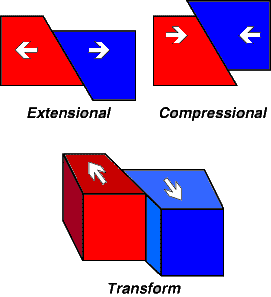BACKGROUND:
Earthquakes are caused by stresses from plate movement
in the upper mantle and crust. Students should understand that stress within
the plates can be "relieved" by giving off energy (earthquakes).
This energy travels through the Earth as seismic waves. These waves move
through the entire Earth and can cause minor to major damage to structures
on the surface of the Earth, especially close to the origin of the
earthquake. The damage depends on the intensity of the original stress and
its dissipation (losing of strength) as it travels through the crust.
The seismic waves generated by an earthquake can be
recorded and measured on a seismograph. The interpretation of the waves
provides seismologists with a way of "seeing" into the inside of
the Earth. The waves produced by earthquakes travel through the Earth and
bounce off different features of the Earth's interior. The patterns they
form after bouncing off these features can be used to create images of the
interior.
The reflection of seismic waves indicates that the
center of the Earth is composed of iron and nickel. This core has two parts,
the outer core where the metal is liquid (not like milk, more like thick
honey) and the inner core, which is solid. The core is surrounded by a layer
called the mantle, which is divided into several sublayers. Basically, most
of the mantle is a mush of crystals and magma (molten rock), perhaps similar
to a snow cone in texture (but much hotter!). The upper part of the mantle
is solid, and is coupled with the crust, the outermost layer of the Earth,
to make the plates. Since we cannot drill even through the Earthís crust,
the evidence from different waves becomes important in interpreting the
earth's structures.
The inner core is about 1200 kilometers in thickness.
The outer core is about 2300 kilometers. The mantle is about 2800
kilometers, while the crust ranges from 7-80 kilometers. The plates average
about 100 kilometers in thickness.
A break in the surface of the Earth is called a fault.
Many large faults are caused by the movement associated with earthquakes.
The word "fault" has several meanings. As a noun it can mean
weakness, blame, blunder, sin, fissure, or fracture; as a verb it can mean
to accuse or blame. Most students think of that meaning when they hear the
term. In geology, the word fault means a zone of weakness in a body of rock
that breaks or moves under stress. On an geological or earthquake map, a
fault is drawn as a black line. However, if you go up in an airplane, you do
not see this line; it is a scientific interpretation of a ground feature.
However, you would see the series of geological and topographic features
that make the faultís location clear to scientists.
PROCEDURE:
- Review with students the structure of the inside of the Earth. Explain
that faults, and hence earthquakes, only occur in the solid, brittle
crust and upper mantle.
 Demonstrate
the different ways that stress is created in the crust and upper
mantle. Stresses within the Earth's crust and outer part of the mantle
causes earthquakes and faults. You can use a glue ball, clay, silly
putty, or just your hands. These movements, which are shown in the
diagram as extensional, compressional, and transform, can be shown as
follows.
Demonstrate
the different ways that stress is created in the crust and upper
mantle. Stresses within the Earth's crust and outer part of the mantle
causes earthquakes and faults. You can use a glue ball, clay, silly
putty, or just your hands. These movements, which are shown in the
diagram as extensional, compressional, and transform, can be shown as
follows.
Extensional refers to a moving away of two areas. This stresses the
rocks on either side and causes a rift. You can use silly putty for this
one, because as you stress it outward you will get a sudden break.
Compressional means that the plates are moving toward each other. These
stresses can be shown with your hands bumping into each other with
force. Neither one wants to move, so there is great stress in the area.
Transform can be easily shown with a glue ball, clay or silly putty. If
you move one side pass the other side, you will form cracks.
- In the lab the students will look at a fault map of the San Francisco
Bay area. Prepare your students for the lab by having students go over a
map of the same area (worksheet). In lab the students will learn the
major faults in this region. If you are a teacher in another area, try
and get a local map of the area that you may have substituted for the
San Francisco Bay area. Almost all areas have faults, although many of
them may not be active (currently storing and releasing stress).
The United States Geological Survey website can be very helpful
to locate local maps. Look at http://www.usgs.gov/
and look under Earthquakes.